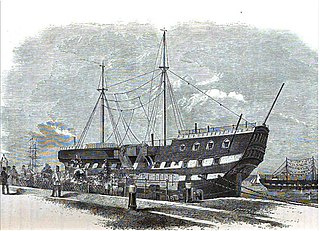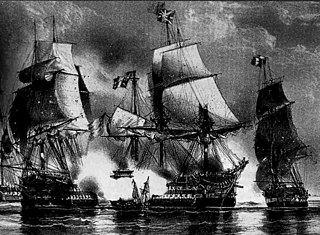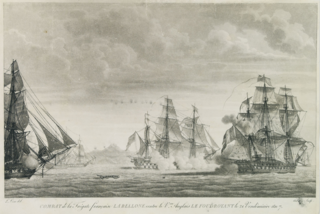The Lyme class were a class of two 24-gun sixth-rate frigates of the Royal Navy. They served during the War of the Austrian Succession and the Seven Years' War.

The Dublin-class ships of the line were a class of seven 74-gun third rates, designed for the Royal Navy by Sir Thomas Slade.

The Ramillies-class ships of the line were a class of nine 74-gun third rates, designed for the Royal Navy by Sir Thomas Slade.

The Ardent-class ships of the line were a class of seven 64-gun third rates, designed for the Royal Navy by Sir Thomas Slade.

The Alfred-class ships of the line were a class of four 74-gun third rates for the Royal Navy by Sir John Williams. They were an enlarged version of the Royal Oak class.

The Courageux-class ships of the line were a class of six 74-gun third rates of the Royal Navy. Their design was a direct copy of the French ship Courageux, captured in 1761 by HMS Bellona. This class of ship is sometimes referred to as the Leviathan class. A further two ships of the class were built to a slightly lengthened version of the Courageux draught. A final two ships were ordered to a third modification of the draught.

The Black Prince-class ships of the line were a class of four 74-gun third rates built for the Royal Navy in the closing years of the Napoleonic War. The draught for this class of ship was essentially a reduced version of the captured Danish ship Christian VII.
The Annibal class was a class of two 74-gun ships of the French Navy. The type was one of the first achievements of Jacques-Noël Sané. His first design - on 24 November 1777 - was for a ship of 166 pieds length, but he produced an amended design on 10 January 1779 for the Annibal, and a further amended design on 3 March 1780 for her near-sister Northumberland. Both ships were captured during the Fourth Battle of Ushant on 1 June 1794 off Ushant, and were added to but never commissioned into the British Navy.

The Tonnant class was a series of eight 80-gun ships of the line designed in 1787 by Jacques-Noël Sané, whose plans for the prototype were approved on 29 September 1787. With sixteen gunports on the lower deck on each side these were the most effective two-deckers of their era. Their broadside of 1,102 livres equated to 1,190 British pounds weight, over 50% more than the standard British 74-gun ship, and even greater than that of a British 100-gun three-decker.

The Canopus-class ships of the line were a class of nine 84-gun two-deck second rates of the Royal Navy. Their design was based on an enlarged version of the lines of the captured French ship Franklin, since commissioned in the Royal Navy as HMS Canopus, although this ship herself was not included as a member of the class. The earlier ships were initially ordered as 80-gun third rates, but this classification was altered by changes in the rating system in February 1817. This class of ships is sometimes referred to as the Formidable class.

The Saint-Esprit group was a type of three 80-gun ships of the line of the French Navy. They did not constitute a single class, as each was built to a separate design, but they each carried a standard ordnance amounting to 80 guns.
The Mermaid-class frigates were a group of six 28-gun sailing frigates of the sixth rate designed in 1760 by Sir Thomas Slade, based on the scaled-down lines of HMS Aurora.

The Iphigénie class was a group of nine 32-gun/12-pounder frigates of the French Navy, built during the late 1770s at Lorient and Saint Malo. They were designed by Léon Guignace. The seven built at Saint Malo were initially numbered Nos. 1 – 7 respectively, and not given names until October 1777 and the start of 1778 ; all seven were captured by the British Navy between 1779 and the end of 1800. Of the two built at Lorient, the Spanish captured one, and a storm wrecked the other.
The Centaure class was a class of 74-gun ships of the line of the French Navy, comprising four ships, all of which built at Toulon Dockyard to a design dated 28 March 1782 by Joseph-Marie-Blaise Coulomb in the year following the close of the American Revolutionary War. The first pair were ordered on 15 February 1782, and were named on 13 April. After the first two ships were begun, the design was amended for the second pair – which are accordingly often described as the Séduisant class. This second pair were ordered on 1 June 1782 and named on 21 August. All four ships were destroyed or captured by the British Royal Navy during the French Revolutionary War.
The Magnifique class was a class of three 74-gun ships of the line, designed and built by Jacques-Luc Coulomb.

The Scipion class was a class of three 74-gun ships of the line built to a design by François-Guillaume Clairin-Deslauriers, the ingénieur-constructeur en chef at Rochefort Dockyard. These were the shortest 74-gun ships built by France since the 1750s, and they were found to lack stability as a consequence. The third ship - originally the Pluton - was 'girdled' (sheathed) with 32 cm of pine at Rochefort in 1799 to overcome her instability, and the design of two further ships ordered at the same dockyard in 1779 were lengthened.

The Roebuck-class ship was a class of twenty 44-gun sailing two-decker warships of the Royal Navy. The class carried two complete decks of guns, a lower battery of 18-pounders and an upper battery of 9-pounders. This battery enabled the vessel to deliver a broadside of 285 pounds. Most were constructed for service during the American Revolutionary War but continued to serve thereafter. By 1793 five were still on the active list. Ten were hospital ships, troopships or storeships. As troopships or storeships they had the guns on their lower deck removed. Many of the vessels in the class survived to take part in the Napoleonic Wars. In all, maritime incidents claimed five ships in the class and war claimed three.
The Magnanime class was a class of two 74-gun ships of the line built for France in the late 1770s. They were designed by Jean-Denis Chevillard, and both were constructed at Rochefort Dockyard.

The Pégase class was a class of 74-gun ships of the French Navy, built to a common design by naval constructor Antoine Groignard. It comprised six ships, all ordered during 1781 and all named on 13 July 1781.

The Abeille class was a type of 16-gun brig-corvette of the French Navy, designed by François Pestel with some units refined by Pierre-Jacques-Nicolas Rolland. They were armed with either 24-pounder carronades, or a mixture of light 6-pounder long guns and lighter carronades. Twenty-one ships of this type were built between 1801 and 1812, and served in the Napoleonic Wars.














